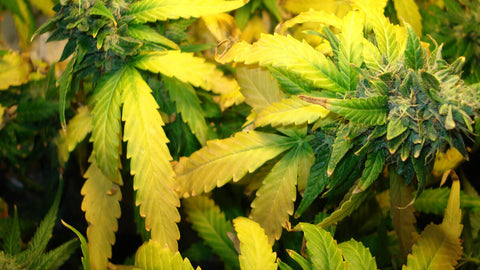Yellow Flags: What It Means When Your Weed Turns Yellow
Witnessing your cannabis plants turn yellow can be alarming for any grower, signaling potential issues that need attention. In this guide, we'll delve into the significance of yellowing cannabis plants, identify potential causes behind this phenomenon, and offer practical solutions to help you maintain the health and vitality of your precious crop. Let's unravel the mysteries of yellow flags and empower you with the knowledge to cultivate thriving cannabis plants.
Understanding Yellowing Cannabis Plants
1. Nutrient Deficiencies:
- Yellowing of cannabis leaves is often indicative of nutrient deficiencies, such as nitrogen, iron, or magnesium. Explore how inadequate nutrient uptake can manifest as chlorosis, causing leaves to turn yellow while veins remain green.
2. Pests and Diseases:
- Infestations by pests like spider mites or diseases like powdery mildew can also cause cannabis leaves to yellow and deteriorate. Learn to identify common pests and diseases that affect cannabis plants and their telltale signs.
Identifying Potential Causes
1. Nutrient Imbalance:
- Imbalances in pH levels or nutrient ratios can disrupt nutrient uptake by cannabis plants, leading to deficiencies and yellowing. Understand the importance of maintaining optimal pH levels and nutrient balance in your growing medium.
2. Environmental Stressors:
- Environmental factors such as excessive heat, cold, or humidity fluctuations can stress cannabis plants, impairing their ability to photosynthesize and absorb nutrients. Explore how to mitigate environmental stressors to prevent yellowing and promote plant health.
Addressing Concerns and Solutions
1. Diagnosing Nutrient Deficiencies:
- Conduct a thorough assessment of your growing environment and nutrient regimen to identify potential deficiencies. Use diagnostic tools like pH meters and nutrient testing kits to pinpoint specific issues.
2. Adjusting Nutrient Feeding:
- Adjust nutrient feeding schedules and formulations based on the specific needs of your cannabis plants. Incorporate supplements or organic amendments to address deficiencies and restore plant health.
3. Implementing Pest Management Strategies:
- Deploy integrated pest management techniques to combat pests and diseases effectively. Consider using natural predators, neem oil, or insecticidal soap to control pest populations while minimizing harm to beneficial organisms.
Troubleshooting Tips for Growers
1. Regular Monitoring:
- Monitor your cannabis plants closely for any signs of yellowing, discoloration, or abnormal growth. Early detection allows for prompt intervention and prevents issues from escalating.
2. Maintaining Ideal Growing Conditions:
- Ensure that your grow room or outdoor environment provides optimal conditions for cannabis cultivation, including adequate lighting, ventilation, temperature, and humidity levels.
3. Consulting with Experts:
- Seek advice from experienced growers or horticultural specialists if you encounter persistent issues with yellowing or other plant health concerns. Collaborate with professionals to diagnose problems and implement effective solutions.
Conclusion: Cultivating Healthy Cannabis Plants
As you navigate the challenges of cannabis cultivation, remember that yellowing is not necessarily a death sentence for your plants. By understanding the potential causes behind yellow flags and taking proactive measures to address concerns, you can nurture healthy, vibrant cannabis plants capable of producing bountiful yields. Armed with knowledge, diligence, and a commitment to plant care, embrace the journey of cultivating thriving cannabis crops and enjoy the rewards of your green-thumb endeavors.
Learn about the visuals behind cannabis through "Beyond the Bud: A Visual Guide to How Weed Looks"

